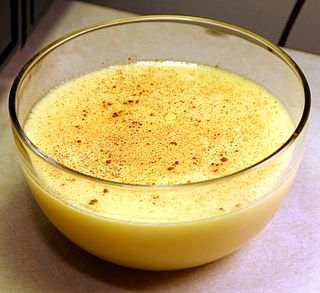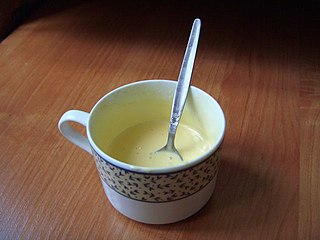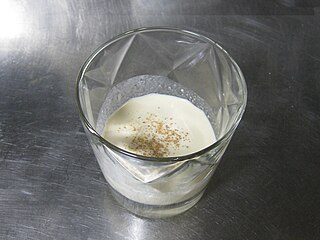
Custard is a variety of culinary preparations based on sweetened milk, cheese, or cream cooked with egg or egg yolk to thicken it, and sometimes also flour, corn starch, or gelatin. Depending on the recipe, custard may vary in consistency from a thin pouring sauce to the thick pastry cream used to fill éclairs. The most common custards are used in custard desserts or dessert sauces and typically include sugar and vanilla; however, savory custards are also found, e.g., in quiche.

Trifle is a layered dessert of English origin. The usual ingredients are a thin layer of sponge fingers or sponge cake soaked in sherry or another fortified wine, a fruit element, custard and whipped cream layered in that order in a glass dish. The contents of a trifle are highly variable and many varieties exist, some forgoing fruit entirely and instead using other ingredients, such as chocolate, coffee or vanilla. The fruit and sponge layers may be suspended in fruit-flavoured jelly, and these ingredients are usually arranged to produce three or four layers. The assembled dessert can be topped with whipped cream or, more traditionally, syllabub.

A caudle was a hot drink that recurred in various guises throughout British cuisine from the Middle Ages into Victorian times. It was thick and sweet, and seen as particularly suitable and sustaining for invalids and new mothers. At some periods of history, caudle recipes were based on milk and eggs, like eggnog. Later variants were more similar to a gruel, a sort of drinkable oatmeal porridge. Like the original forms of posset, a caudle was usually alcoholic.

The Forme of Cury is an extensive 14th-century collection of medieval English recipes. Although the original manuscript is lost, the text appears in nine manuscripts, the most famous in the form of a scroll with a headnote citing it as the work of "the chief Master Cooks of King Richard II". The name The Forme of Cury is generally used for the family of recipes rather than any single manuscript text. It is among the oldest extant English cookery books, and the earliest known to mention olive oil, gourds, and spices such as mace and cloves.

Cheesecake is a dessert made with a soft fresh cheese, eggs, and sugar. It may have a crust or base made from crushed cookies, graham crackers, pastry, or sometimes sponge cake. Cheesecake may be baked or unbaked, and is usually refrigerated.

Fondue is a Swiss melted cheese and wine dish served in a communal pot over a portable stove heated with a candle or spirit lamp, and eaten by dipping bread and sometimes vegetables into the cheese using long-stemmed forks. It was promoted as a Swiss national dish by the Swiss Cheese Union in the 1930s, and was popularized in North America in the 1960s.

Eggnog, historically also known as a milk punch or an egg milk punch when alcoholic beverages are added, is a rich, chilled, sweetened, dairy-based beverage. It is traditionally made with milk, cream, sugar, egg yolks, and whipped egg whites. A distilled spirit such as brandy, rum, whiskey or bourbon is often a key ingredient.

Syllabub is a sweet dish made by curdling sweet cream or milk with an acid such as wine or cider. It was a popular British confection from the 16th to the 19th centuries.

Junket is a milk-based dessert, made with sweetened milk and rennet, the digestive enzyme that curdles milk. Some older cookery books call the dish curds and whey.
Aleberry is a beverage made by boiling ale with spice, sugar and bread-sops, the last commonly toasted. It is sweetened, strained, and drunk hot.

Kogel mogel is an egg-based homemade dessert once popular in parts of Europe. It is made from egg yolks, sugar, and flavourings such as honey, vanilla, cocoa or rum, similar to eggnog or zabaione. In its classic form it is served slightly chilled or at room temperature. Served warm or hot, it is considered a home remedy for sore throats. Variations include milk, honey and soda.

Scottish cuisine encompasses the cooking styles, traditions and recipes associated with Scotland. It has distinctive attributes and recipes of its own, but also shares much with other British and wider European cuisine as a result of local, regional, and continental influences—both ancient and modern.

Figgy pudding or fig pudding is any of many medieval Christmas dishes, usually sweet or savory cakes containing honey, fruits and nuts. In later times, rum or other distilled alcohol was often added to enrich the fruitiness of the flavour.

Milk punch is a milk-based brandy or bourbon beverage. It consists of milk, the spirit, sugar, and vanilla extract. It is served cold and usually has nutmeg sprinkled on top. Milk punch may be clarified through the addition of ingredients which cause the milk to curdle, so that the solids contributing to the beverage's opacity may be strained out.

Rompope is an eggnog drink made with eggs, milk, and vanilla flavouring. The egg yolks impart a yellow hue to the emulsified beverage. It is a traditional drink known as such in Honduras, Costa Rica, Ecuador, Nicaragua, El Salvador, Guatemala, Belize and particularly in Mexico, where it is believed to have been originally made in the convents of the city of Puebla, Mexico. The word rompope is a derivation of the word rompon, which is used to describe the Spanish version of eggnog that came to Mexico. The Spanish version utilizes rum as its main ingredient, hence the root of both rom-pon and rom-pope, but in Central America, Guatemala, Honduras and El Salvador, there is also a similar beverage known as rompopo. For example, Salcaja, in Guatemala, offers one known version of this rompope drink and in South America, the country of Chile has among its most popular drinks rompon and cola de mono or monkey's tail, the latter containing coffee, making it dark instead of yellow, but also containing the other ingredients commonly found in rompope.

The Queen-like Closet, Or, Rich Cabinet was a cookery book published in 1670 by the English writer on household management, Hannah Woolley. It ran through five English editions by 1684. At least two German editions were also printed.

This Is the Boke of Cokery, or The Boke of Cokery, is believed to be the first cookery book printed in English. The name of the author is unknown. It was printed and published by Richard Pynson in 1500. The book remained in print for many years in the 16th century, but was superseded and forgotten by the 18th. The only known surviving copy of the book is in the possession of the Marquess of Bath at Longleat House, Wiltshire.


















